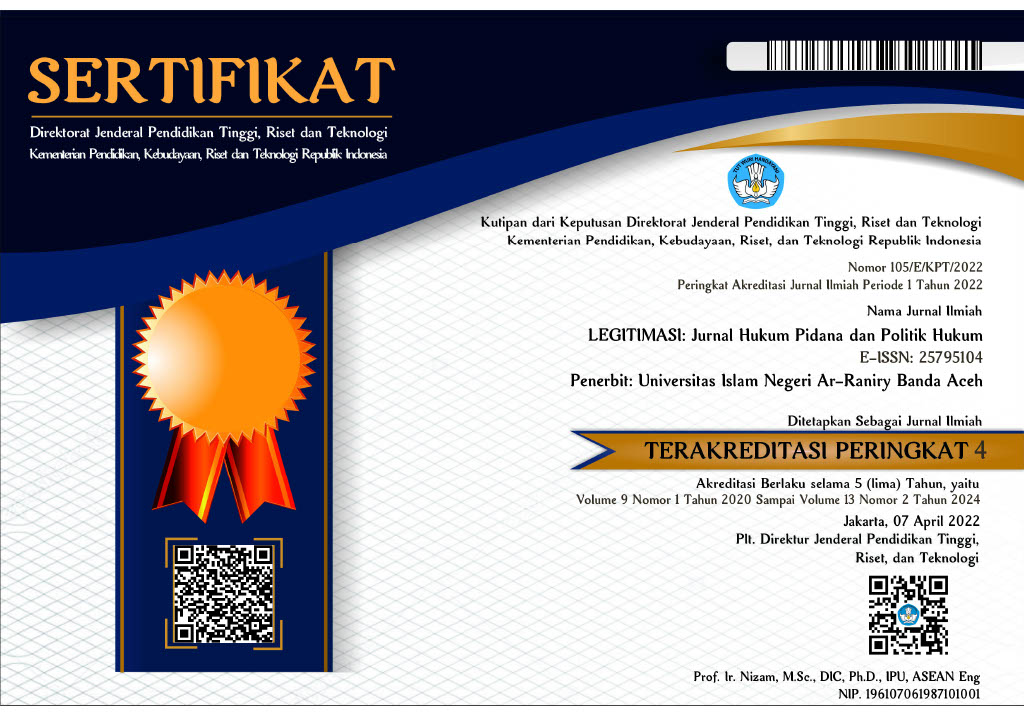Development of Aceh's Adat Judicial System [Perkembangan Sistem Hukum Peradilan Adat Aceh]
Abstract
Abstract: Aceh’s customary court is a peace court that are intended to resolve such cases as disputes or customary violations that occur in the community. Several terms are used to refer to customary courts, including gampong courts and peace courts. Settlement of disputes in customary law communities is based on the view of life held by the Acehnese community. Acehnese community have a democratic nature in which common interests is in the top priority, without neglecting individual interests. A democratic and social justice life atmosphere goes hand in hand with a communal spirit and cooperation. in customary law communities. Democratic behavior is inspired by the principle of customary law which has universal value. This value is in the form of general power, the principle of deliberation, and representation in the customary government system. The research questions in this study are what the concept of mediation as an alternative to customary courts is applied in Aceh. What principles are contained in the implementation of customary justice in Aceh? The research method uses empirical sociological research, using a statutory and customary law cases approach. The research finding is in the Acehnese community the implementation of customary justice is supported by several laws and regulations. In these various laws and regulations, it is expressly stated that the strengthening of customary law and customary courts must start from the Gampong and Mukim. The official institutions that administer customary justice are the Gampong Institution and the Mukim Institution.
Abstrak: Peradilan adat Aceh adalah peradilan perdamaian yang dimaksudkan untuk menyelesaikan perkara (sengketa atau pelanggaran adat) yang terjadi dalam masyarakat, beberapa istilah yang digunakan dalam menyebutkan peradilan adat, diantaranya peradilan gampong dan peradilan damai. Penyelesaian sengketa dalam masyarakat hukum adat didasarkan pada pandangan hidup yang dianut oleh masyarakat itu sendiri. Masyarakat adat memiliki sifat demokratis yang mana kepentingan bersama lebih diutamakan, tanpa mengabaikan atau merugikan kepentingan perorangan. Suasana hidup demokratis dan berkeadilan sosial berjalan bersama dengan semangat komunal dan gotong royong dalam masyarakat hukum adat. Prilaku demokratis dijiwai oleh asas hukum adat yang bernilai universal. Nilai ini berupa kekuasaan umum, asas musyawarah, dan perwakilan dalam sistem pemerintahan adat. Adapun yang menjadi rumusan masalah dalam penelitian ini adalah; Bagaimana Konsep Mediasi Sebagai Sebuah Alternatif Peradilan Adat. Bagaimana Sistem Hukum Peradilan Adat. Asas-asas apa saja yang termuat dalam pelaksanaan peradilan adat di Aceh. Metode penelitian menggunakan jenis penelitian sosiologi empiris, dengan menggunakan pendekatan peraturan perundang-undangan dan pendekatan kasus adat yang mendapatkan penyelesaian. Hasil penelitian yang ditemukan di masyarakat lembaga adat aceh bahwa Pelaksanaan peradilan adat didukung oleh sejumlah peraturan perundang-undangan. Di dalam berbagai peraturan perundang-undangan tersebut dinyatakan secara tegas bahwa penguatan hukum adat dan peradilan adat harus dimulai dari Gampong dan Mukim. Adapun badan-badan resmi yang menyelenggarakan peradilan adat yaitu Lembaga Gampong dan Lembaga Mukim.
Keywords
Full Text:
PDFReferences
MAANGO, Majelis Adat Aceh Negeri Gayo. Prinsip-prinsip Dasar PelaksanaanPeradilan Adat (1). Takengon: Majelis Adat Aceh Negeri Gayo (MAANGO), 2008.
Abdurrahaman. Peradilan Adat di Aceh sebagai Sarana Kerukunan Masyarakat. Banda Aceh: Majelis Adat Aceh, 2009.
Adhani, Hani. “Menakar Konstitusionalitas Syari’at Islam dan Mahkamah Syar’iyah di Provinsi Aceh.” Jurnal Konstitusi 16, no. 3 (2019): 606–18.
Arief, Barda Nawawi. Mediasi Penal, Penyelesaian Perkara diluar Pengadilan. Semarang: Pustaka Magister, 2010.
Benda-Beckmann, Keebet von. “Anachronism, Agency, and the Contextualisation of Adat: Van Vollenhoven’s Analyses in Light of Struggles Over Resources.” The Asia Pacific Journal of Anthropology 20, no. 5 (2019): 397–415.
Christianto, Hwian. “Measuring cyber pornography based on Indonesian living law: A study of current law finding method.” International Journal of Law, Crime and Justice 60 (2020).
Diala, Anthony C. “The concept of living customary law: a critique.” The Journal of Legal Pluralism and Unofficial Law2017 49, no. 2 (n.d.).
Dzhabayeva, Takhmina Ch. “The Problem of Introduction Of Civil Administration And Judicial Proceedings Of The Tsarist Administration In Dagestan In The Mid-19th Century (based on the materials of Derbent district).” Vestnik of Kostroma State University, no. 3 (2020): 51–63.
Gallegos Anda, Carlos E. “Good Living as a Living Law.” The Australian Journal of Indigenous Education 47, no. 1 (2018): 30–40.
Horii, Hoko. “Pluralistic legal system, pluralistic human rights?: teenage pregnancy, child marriage and legal institutions in Bali.” The Journal of Legal Pluralism and Unofficial Law 51, no. 3 (2019): 292–319.
Huizenga, Daniel. “Articulations of Aboriginal Title, Indigenous Rights, and Living Customary Law in South Africa.” Social & Legal Studies 29, no. 1 (2018): 3–24.
Ismail, Badruzzaman., dkk. Ensiklopedia Budaya Adat Aceh. Banda Aceh: Majelis Adat Aceh, 2018.
Ismail, Badruzzaman. Membangun Keistimewaan Aceh dari Sisi Adat dan Budaya: Histories dan Sosiologisnya. Banda Aceh: Majelis Adat Aceh, 2007.
Itam, Teuku Raja. “Penyelesaian Sengketa dan Bebagai Kasus.” In Pedoman Adat Aceh: Peradilan dan Hukum Adat, diedit oleh M. Isa Sulaiman dan H. T. Syamsuddin. Banda Aceh: LAKA, 2001.
Lukito, Ratno. “Law and Politics in Post Independence Indonesia: A Case Study of Religious and Adat Courts.” Studia Islamika 6, no. 2 (2014).
Mahdi. “Eksistensi Peradilan Adat di Aceh.” HUNAFA: Jurnal Studia Islamika 8, no. 2 (2011). https://www.jurnalhunafa.org/index.php/hunafa/article/view/362.
Mulyadi, Lilik. “Mediasi Penal Dalam Sistem Peradilan Pidana Indonesia: Pengkajian Asas, Norma, Teori Dan Praktik.” Yustusia: Jurnal Hukum 2, no. 1 (2013). https://jurnal.uns.ac.id/yustisia/article/view/11054/9892.
Pinan, Mahmud Ibrahim dan Hakim Aman. Syariat dan Adat Istiadat. Takengon: Yayasan Maqamam Mahmuda, 2002.
Pradhani, Sartika Intaning. “Dynamics of Adat Law Community Recognition: Struggle To Strengthen Legal Capacity.” Mimbar Hukum - Fakultas Hukum Universitas Gadjah Mada 31, no. 2 (2019): 279.
Rato, Dominikus. “Legal Conflicts in the Border Dispute between Indonesia and Timor Leste.” Lentera Hukum 6, no. 3 (2019): 349–61.
Setiady, Tolib. Intisari Hukum adat indonesia. Jakarta: Alfabet, 2013.
Soesilo, R. Kitab Undang-Undang Hukum Acara Pidana. Bogor: Politea, 1996.
Sudiyat, Iman. Hukum Adat (Sketsa Asas). Yogyakarta: Liberty, 1981.
Sudantra, I Ketut. “Urgensi Dan Strategi Pemberdayaan Peradilan Adat dalam Sistem Hukum Nasional.” Journal of Indonesian Adat Law (JIAL) 2, no. 3 (2018): 122–46.
DOI: http://dx.doi.org/10.22373/legitimasi.v10i1.10522
Refbacks
- There are currently no refbacks.
Copyright (c) 2021 Sitti Mawar

This work is licensed under a Creative Commons Attribution-NonCommercial-ShareAlike 4.0 International License.
Published by Islamic Criminal Law Department, Faculty of Sharia and Law, Universitas Islam Negeri Ar-Raniry Banda Aceh.

























